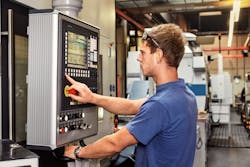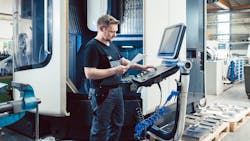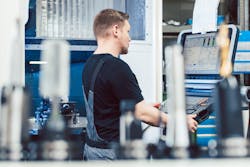Computer Numerical Control (CNC) machines are automated or computer-driven motion control machines that have helped make the manufacturing industry more efficient. These tools are so efficient that they can create things outs of almost any hard materials.
However, when it comes to technical flaws, design oversights, and other software glitches, no technology is perfect, and CNC machines are no different.
From jamming parts to power supply failure and erroneous tool cutting to wrong programming, an entire gamut of issues may crop up during the machining process, which may overwhelm manufacturers. However, there are always various ways to fix them.
Here's a look at some of the commonly encountered issues in the setup and maintenance of CNC machines with potential remedies to correct them.
Common Issues With CNC Machines and How to Fix Them
Any good machine runs on the fundamental principle of proper setup and functioning. Derailing from this principle can result in an array of issues with the CNC machines. Here are some common issues that majorly contribute to malfunctions and maintenance issues in CNC machines.
1. Errors in Codes
Perhaps one of the major issues that trouble computer-driven machines can be attributed to errors in programming. These programming errors could either come from the lack of understanding of the fundamentals of different G and M codes or from writing wrong data variables into the controller of the CNC machine. If the programming is erroneous, the machines will not function properly.
- How to Fix: To ensure that there are no particular errors in the machines at the level of codes, the CNC machining center should hire excellent coders who are adept at writing good codes. Machine operators should also be well-versed in the comprehensive user manuals to know the CNC machines inside out.
2. Poor Maintenance
Machines that require constantly moving mechanical systems must be regularly maintained to function at their optimal best. Such tools must be cleaned so that any dirt, material, or debris does not jam the machines. Failure to regularly maintain can lead to debris and dirt build-up over time, resulting in machines' failures and inaccuracies.
- How to Fix: The only and the best way to resolve this issue is to ensure that machine operators follow a regular maintenance and clean-up routine for their CNC machines. Besides cleaning dirt and dust, machine operators should frequently check air filters more prone to debris.
3. Machine Vibration Issues
The efficiency of some machines can be measured by how well it vibrates. However, with CNC machines, vibrations are not recommended. If a CNC machine vibrates while performing a task, it could potentially reduce the lifespan of that tool. It may also affect its durability and long-term functionality. CNC machines that take more time than doing a task that, on average, take less time are cost-effective, and the workshop managers may have to put up the CNC milling machines for sale.
- How to Fix: To identify the machine's vibration issues, the machine operator must diagnose whether the chatter comes from the workpiece or the tool itself. They can try adjusting the machine's RPM using a balanced tool holder. Try maintaining spindle speeds above 8,000 RPM.
4. Incorrect Settings Selection
Selecting an incorrect or inapplicable setting for a specific task often results in poor-quality material finishes. A custom CNC machining must have pre-selected appropriate cutting tools and settings to work precisely. Incorrect settings result in burn marks, rough corners, blunt edges, or visible marks.
- How to Fix: To rectify this, operators must choose appropriate settings, ensure proper clamping, and set up the hydraulic pump and pressure before operating machines. Parts must be correctly positioned, and other tools should be adequately set up.
5. Overheating
CNC machines run for extended periods and perform a high volume of daily tasks without resting, which may cause overheating. Machinery experts advise that a regular CNC machine should not hit temperatures beyond 150 degrees. Overheating comes with its own sets of problems that may adversely affect these machines.
- How to Fix: Mainly overheating happens due to an irregular maintenance regime, such as not regularly cleaning and clearing all channels within the system from dirt, material, and debris. This means the machine operator needs to clean the machine regularly.
Overheating can also result when the CNC machine continuously runs at the highest RPM. While some CNC machines that run on oil-jet lubrication can run at the highest RPM for a prolonged period, not all spindles are the beast. Depending on the CNC machine, the working duration of these machines should be decided.
Issues with overheating can also happen due to variations in temperatures in the environment where the machine is placed. If the workshop is not properly ventilated, it may cause the environmental temperature to influence the engine to overheat. Thus, the workshop managers should place the CNC machining sufficiently exposed to air and sunshine.
6. Incompatible Power Supply
CNC machines are highly complex in their building, and they may display specific issues with their functioning due to power supply problems. This is why CNC machines must operate at appropriate power supply settings.
- How to Fix: To resolve this issue, the machine operator should ensure that the correct power and voltage supply is used for the power and supply input. If the power or voltage is low or no one, try disconnecting output wires when the power is off. While an elementary system examination for power issues can be done, it is always recommended to consult an electrician or a specialist to check for issues related to power or connections.
7. Lack of Trained Operators
Human errors are unavoidable. But hiring untrained or semi-trained operators can lead to more human errors. Operating CNC machines require years of training; thus, the operators need to be trained in the machine.
- How to Fix: Hire skilled workers and continuously organize training workshops on the machines, especially when new machinery upgrades are made.
Conclusion
CNC machines are vulnerable to various operational and technical issues like any other technological tool. For this reason, operators and workshop managers need to exercise stringent measures and precautions to ensure that the machines run effortlessly and produce a high-quality product finish.
About the Author
Vincent Hua
Marketing Manager, TSINFA
Vincent Hua is the Marketing Manager at TSINFA. He is passionate about helping people understand high-end and complex manufacturing processes.
Besides writing and contributing his insights, Vincent is very keen on technological innovation that helps build highly precise and stable CNC Machinery.



